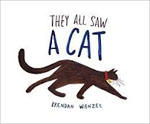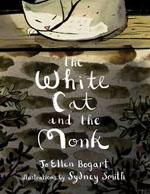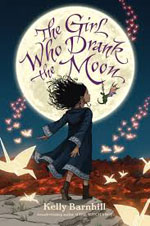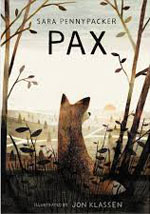The season for looking back is upon us, and best-of-the-year booklists are popping up in the media. After reading so many books, having a few favorites is natural. Here are some notable fiction offerings of 2016.
Ages 4–8
Du Iz Tak? Carson Ellis. 2016. Candlewick.
 As a tiny, green shoot emerges and grows and grows, a year of insect mini-dramas unfolds in clever, brightly colored gouache-and-ink illustrations, accompanied by a text made solely of invented dialogue. A damselfly exclaims, “Unk gladdenboot!” during the big spring reveal of a flower, but it is not long before the land returns to its fallow state, and it’s time to begin again—“Du iz tak?”—as new shoots appear. Children can read the pictures to tell the story and enjoy translating the text.
As a tiny, green shoot emerges and grows and grows, a year of insect mini-dramas unfolds in clever, brightly colored gouache-and-ink illustrations, accompanied by a text made solely of invented dialogue. A damselfly exclaims, “Unk gladdenboot!” during the big spring reveal of a flower, but it is not long before the land returns to its fallow state, and it’s time to begin again—“Du iz tak?”—as new shoots appear. Children can read the pictures to tell the story and enjoy translating the text.
School’s First Day of School. Adam Rex. Ill. Christian Robinson. 2016. Neal Porter/Roaring Brook.
 With colorful paint-and-collage artwork, this picture book offers a fresh and fun perspective on first-day jitters as a new building, Frederick Douglass Elementary, nervously opens his doors to students. So far, his only human contact has been with the janitor. At day’s end, School is eager to report to the janitor about his big day and asks him to invite everyone to come back the next morning.
With colorful paint-and-collage artwork, this picture book offers a fresh and fun perspective on first-day jitters as a new building, Frederick Douglass Elementary, nervously opens his doors to students. So far, his only human contact has been with the janitor. At day’s end, School is eager to report to the janitor about his big day and asks him to invite everyone to come back the next morning.
They All Saw a Cat. Brendan Wenzel. 2016. Chronicle.
 “The cat walked through the world, with its whiskers, ears, and paws...” and “the child saw A CAT, and the dog saw A CAT,” and 10 other animals saw the cat. How each animal saw the tabby cat from its own perspective, colored by its knowledge and emotional response to the encounter, is brilliantly conveyed in imaginative double-page illustrations, rendered in a variety of materials, which complete the rhythmic patterned text of this imaginative picture book.
“The cat walked through the world, with its whiskers, ears, and paws...” and “the child saw A CAT, and the dog saw A CAT,” and 10 other animals saw the cat. How each animal saw the tabby cat from its own perspective, colored by its knowledge and emotional response to the encounter, is brilliantly conveyed in imaginative double-page illustrations, rendered in a variety of materials, which complete the rhythmic patterned text of this imaginative picture book.
We Found a Hat. Jon Klassen. 2016. Candlewick.
 In this final book in Klassen’s hat trilogy, two tortoises find a spiffy 10-gallon hat. The dilemma: How can the friends both wear the hat at the same time, especially when one of them secretly really wants it? Can they “dream up” a solution that works for both of them? The minimalistic artwork, in desert-like pink, grey, and brown tones, and simple narrative of this warm, gently humorous tale of friendship, will enchant children.
In this final book in Klassen’s hat trilogy, two tortoises find a spiffy 10-gallon hat. The dilemma: How can the friends both wear the hat at the same time, especially when one of them secretly really wants it? Can they “dream up” a solution that works for both of them? The minimalistic artwork, in desert-like pink, grey, and brown tones, and simple narrative of this warm, gently humorous tale of friendship, will enchant children.
The White Cat and the Monk: A Retelling of the Poem “Pangur Bán.” Jo Ellen Bogart. Ill. Sydney Smith. 2016. Groundwood/House of Anansi.
 Panels of watercolor-and-ink paintings on wordless pages set the scene as a white cat prowls the halls of a monastery and makes its way into the cell of a Benedictine monk. The scholar compares his solitary life to that of the cat in this quiet tale of companionship in the Middle Ages. “We are each content, with all we need to entertain us. Ours is a happy tale.”
Panels of watercolor-and-ink paintings on wordless pages set the scene as a white cat prowls the halls of a monastery and makes its way into the cell of a Benedictine monk. The scholar compares his solitary life to that of the cat in this quiet tale of companionship in the Middle Ages. “We are each content, with all we need to entertain us. Ours is a happy tale.”
Ages 9–11
The Best Man. Richard Peck. 2016. Dial/Penguin.
 Archer Magill chronicles his elementary school years, beginning with an embarrassing wedding experience as a ring bearer at the age of 6. Through the highs and lows of subsequent years, Archer has three role models: Dad, Grandpa Magill, and Uncle Paul. Then he adds another, his fifth-grade student teacher, Mr. MacLeod. Archer concludes his “Tale of Two Weddings” as he serves as best man for Uncle Paul and Mr. MacLeod at their wedding in June after his year in sixth grade.
Archer Magill chronicles his elementary school years, beginning with an embarrassing wedding experience as a ring bearer at the age of 6. Through the highs and lows of subsequent years, Archer has three role models: Dad, Grandpa Magill, and Uncle Paul. Then he adds another, his fifth-grade student teacher, Mr. MacLeod. Archer concludes his “Tale of Two Weddings” as he serves as best man for Uncle Paul and Mr. MacLeod at their wedding in June after his year in sixth grade.
The Girl Who Drank the Moon. Kelly Barnhill. 2016. Algonquin.
 A baby left in the forest in the Protectorate’s annual sacrifice is rescued by a good witch, Xan, who mistakenly lets the infant drink moonlight, thus she becomes enmagicked. Xan (with the help of a swamp monster and a Perfectly Tiny Dragon) must raise the child, Luna, to keep her magic confined until she’s old enough to control it. At the age of 13, Luna’s magic emerges and she uses it in a tangle of complex interactions involving her three guardians, an evil sorceress, and humans.
A baby left in the forest in the Protectorate’s annual sacrifice is rescued by a good witch, Xan, who mistakenly lets the infant drink moonlight, thus she becomes enmagicked. Xan (with the help of a swamp monster and a Perfectly Tiny Dragon) must raise the child, Luna, to keep her magic confined until she’s old enough to control it. At the age of 13, Luna’s magic emerges and she uses it in a tangle of complex interactions involving her three guardians, an evil sorceress, and humans.
The Inquisitor’s Tale: Or, The Three Magical Children and Their Holy Dog. Adam Gidwitz. Ill. Hatem Aly. 2016. Dutton/Penguin.
 In 1242, travelers gathered in a French tavern contribute stories about a dog and three children with supernatural powers. Gwenforte, the dog, was killed but came back to life. Jeanne, a peasant, sees the future. William, an oblate, has super strength. Jacob, a young Jewish boy, has the power to heal wounds. Aly’s manuscript illuminations are an integral part of this epic adventure as the children and their dog elude the inquisition.
In 1242, travelers gathered in a French tavern contribute stories about a dog and three children with supernatural powers. Gwenforte, the dog, was killed but came back to life. Jeanne, a peasant, sees the future. William, an oblate, has super strength. Jacob, a young Jewish boy, has the power to heal wounds. Aly’s manuscript illuminations are an integral part of this epic adventure as the children and their dog elude the inquisition.
Pax. Sara Pennypacker. Ill. Jon Klassen. 2016. Balzer + Bray/HarperCollins.
 Twelve-year-old Peter is being sent to live with his grandfather. His father is going off to war and insists that Pax, a fox and Peter’s companion for five years, be released in the wild. Pax doesn’t understand his abandonment; Peter realizes the wrongness of the separation. Boy and fox have encounters that change them, and Peter comes to understand that a reunion with Pax may not be in Pax’s best interest, even if it is possible.
Twelve-year-old Peter is being sent to live with his grandfather. His father is going off to war and insists that Pax, a fox and Peter’s companion for five years, be released in the wild. Pax doesn’t understand his abandonment; Peter realizes the wrongness of the separation. Boy and fox have encounters that change them, and Peter comes to understand that a reunion with Pax may not be in Pax’s best interest, even if it is possible.
Raymie Nightingale. Kate DiCamillo. 2016. Candlewick.
 When her father runs off with a dental hygienist, 10-year-old Raymie sets out to win the Little Miss Central Florida Tire contest so he’ll return home to his famous daughter. Unfortunately, Raymie has no talent for baton twirling. However, two contestants, who also have special reasons for wanting to win, become her best friends as they work on pageant-required service projects. By the end of the contest, the futures of all the girls look brighter.
When her father runs off with a dental hygienist, 10-year-old Raymie sets out to win the Little Miss Central Florida Tire contest so he’ll return home to his famous daughter. Unfortunately, Raymie has no talent for baton twirling. However, two contestants, who also have special reasons for wanting to win, become her best friends as they work on pageant-required service projects. By the end of the contest, the futures of all the girls look brighter.
When the Sea Turned to Silver. Grace Lin. 2016. Little, Brown.
 Grace Lin weaves ancient Chinese folktales into an epic adventure in which Pinmei and her mysterious friend Vishan set out on a perilous quest during a never-ending winter to find the Luminous Stone That Lights the Night. She intends to offer the stone, which the Tiger Emperor covets, in exchange for the release of her beloved grandmother, Amah the Storyteller. Lin’s richly colored, intricately detailed illustration and spot art illuminate this companion to Where the Mountain Meets the Moon (2009) and Starry River of the Sky (2012).
Grace Lin weaves ancient Chinese folktales into an epic adventure in which Pinmei and her mysterious friend Vishan set out on a perilous quest during a never-ending winter to find the Luminous Stone That Lights the Night. She intends to offer the stone, which the Tiger Emperor covets, in exchange for the release of her beloved grandmother, Amah the Storyteller. Lin’s richly colored, intricately detailed illustration and spot art illuminate this companion to Where the Mountain Meets the Moon (2009) and Starry River of the Sky (2012).
Ages 12–14
The Boy at the Top of the Mountain. John Boyne. 2016. Henry Holt.
 In 1936, orphaned 7-year-old Pierrot moves into the Austrian retreat of Adolf Hitler, where his aunt is the housekeeper. Becoming the Führer’s special pet, he transforms from a naïve child into an adolescent who, idolizing Hitler and completely committed to Nazi supremacy, betrays those who have treated him with love and kindness. As World War II ends, he has learned some important lessons, but they come too late to atone for his actions.
In 1936, orphaned 7-year-old Pierrot moves into the Austrian retreat of Adolf Hitler, where his aunt is the housekeeper. Becoming the Führer’s special pet, he transforms from a naïve child into an adolescent who, idolizing Hitler and completely committed to Nazi supremacy, betrays those who have treated him with love and kindness. As World War II ends, he has learned some important lessons, but they come too late to atone for his actions.
Ghost (Track #1). Jason Reynolds. 2016. Caitlyn Dlouhy/Atheneum/Simon & Schuster.
 Seventh-grader Castle “Ghost” Cranshaw is always running, either away from trouble as when he and his mother had to run when his drunk father threatened them with a gun or toward trouble or “altercations” at school. When he is recruited as a sprinter by the Olympic medalist coach of an elite youth track team, Ghost has the opportunity to develop his natural talent as a runner—if he can control his anger and move beyond his troubled past.
Seventh-grader Castle “Ghost” Cranshaw is always running, either away from trouble as when he and his mother had to run when his drunk father threatened them with a gun or toward trouble or “altercations” at school. When he is recruited as a sprinter by the Olympic medalist coach of an elite youth track team, Ghost has the opportunity to develop his natural talent as a runner—if he can control his anger and move beyond his troubled past.
The Lie Tree. Frances Hardinge. 2016. Amulet/Abrams.
 In this blending of fantasy and historical mystery, Reverend Erasmus Sunderly, a gentleman natural scientist, whisks his family away from Victorian London to the remote island of Vane, ostensibly to participate in an archaeological dig, but more likely to escape scandal involving an accusation of faking fossil finds. Fourteen-year-old Faith becomes aware of her father’s conflict with the men involved with the dig. When he is found dead, she is determined to prove that he did not commit suicide.
In this blending of fantasy and historical mystery, Reverend Erasmus Sunderly, a gentleman natural scientist, whisks his family away from Victorian London to the remote island of Vane, ostensibly to participate in an archaeological dig, but more likely to escape scandal involving an accusation of faking fossil finds. Fourteen-year-old Faith becomes aware of her father’s conflict with the men involved with the dig. When he is found dead, she is determined to prove that he did not commit suicide.
Snow White: A Graphic Novel. Matt Phelan. 2016. Candlewick.
 Phelan’s nearly wordless retelling of Snow White recasts characters and sets the tale in New York City in the 1920s and 1930s. After the death of her mother, Samantha (“Snow”) White’s father, the King of Wall Street, marries the Queen of the Follies. Learning Samantha is heir to her father’s fortune, the evil stepmother hires a thug to kill her. Like the classic huntsman, he spares Samantha’s life. A gang of seven street urchins protect her, and a police detective takes the place of the prince for a happy ending.
Phelan’s nearly wordless retelling of Snow White recasts characters and sets the tale in New York City in the 1920s and 1930s. After the death of her mother, Samantha (“Snow”) White’s father, the King of Wall Street, marries the Queen of the Follies. Learning Samantha is heir to her father’s fortune, the evil stepmother hires a thug to kill her. Like the classic huntsman, he spares Samantha’s life. A gang of seven street urchins protect her, and a police detective takes the place of the prince for a happy ending.
To Stay Alive: Mary Ann Graves and the Tragic Journey of the Donner Party. Skila Brown. 2016. Candlewick.
 In the spring of 1846, Mary Ann Graves (an actual survivor of the ill-fated crossing of the Sierra Nevada range by members of the Donner Party) and her family leave their home in Illinois for California. Lyrical poetry conveys the hardships the wagon train encounters as it moves across the vast wilderness and into the unexpected harshness of an early winter, which brings a shift from enthusiasm for a trailblazing adventure to despair among the starving and freezing pioneers.
In the spring of 1846, Mary Ann Graves (an actual survivor of the ill-fated crossing of the Sierra Nevada range by members of the Donner Party) and her family leave their home in Illinois for California. Lyrical poetry conveys the hardships the wagon train encounters as it moves across the vast wilderness and into the unexpected harshness of an early winter, which brings a shift from enthusiasm for a trailblazing adventure to despair among the starving and freezing pioneers.
Age 15+
The Memory of Light.  Francisco X. Stork. 2016. Arthur A. Levine/Scholastic.
Francisco X. Stork. 2016. Arthur A. Levine/Scholastic.
Working with a therapist and getting to know the three teens in her therapy group in a psychiatric hospital after a failed suicide attempt, 16-year-old Vicky realizes she needs this supportive environment. Her father and stepmother, however, want her home and back to a “normal” routine. Stork tells the story of Vicky’s movement from the darkness of clinical depression to recovery to the point that she can return home with the strength to live if she has control over what that life will be.
Salt to the Sea. Ruta Sepetys. 2016. Philomel/Penguin.
 World War II is nearing an end, and a group of refugees bands together, surviving unbelievable hardships, to reach an East Prussian port, where Germany is carrying out a sea evacuation of soldiers and civilians. Escape to freedom aboard the Wilhelm Gustloff turns disastrous as the ship is sunk by a Soviet submarine. Told through alternating points of view of four characters (three refugees and a German sailor), this novel lets readers live the events leading up to—and following—this heartbreaking epic, based on an actual tragedy of war.
World War II is nearing an end, and a group of refugees bands together, surviving unbelievable hardships, to reach an East Prussian port, where Germany is carrying out a sea evacuation of soldiers and civilians. Escape to freedom aboard the Wilhelm Gustloff turns disastrous as the ship is sunk by a Soviet submarine. Told through alternating points of view of four characters (three refugees and a German sailor), this novel lets readers live the events leading up to—and following—this heartbreaking epic, based on an actual tragedy of war.
Scythe (Arc of a Scythe). Neal Shusterman. 2016. Simon & Schuster.
 In a future world that has conquered death, a supercomputer, the “Thunderhead,” runs daily societal systems while professional scythes glean (kill) to keep population size under control. Teens Citra and Rowan, unwillingly pitted against each other as apprentice scythes (with the winner destined to glean the loser) uncover a political conspiracy to destroy their perfect society with stakes higher than their own lives. Scythe leaves the reader eagerly awaiting the next book in the series.
In a future world that has conquered death, a supercomputer, the “Thunderhead,” runs daily societal systems while professional scythes glean (kill) to keep population size under control. Teens Citra and Rowan, unwillingly pitted against each other as apprentice scythes (with the winner destined to glean the loser) uncover a political conspiracy to destroy their perfect society with stakes higher than their own lives. Scythe leaves the reader eagerly awaiting the next book in the series.
The Sun Is Also a Star. Nicola Yoon. 2016. Delacorte/Random House.
 Two teens meet in New York City and fall in love during a 12-hour period. Natasha, an undocumented immigrant from Jamaica, is being deported that evening. Daniel, a Korean American, is in the city for a Yale interview. His parents, Korean immigrants, insist that he pursue a medical career; Daniel wants to be a poet. At the end of the day, they separate. Their lives have been changed by their time together and encounters with others. Parting is a sad reality, but there is hope. The universe is full of possibilities for the future.
Two teens meet in New York City and fall in love during a 12-hour period. Natasha, an undocumented immigrant from Jamaica, is being deported that evening. Daniel, a Korean American, is in the city for a Yale interview. His parents, Korean immigrants, insist that he pursue a medical career; Daniel wants to be a poet. At the end of the day, they separate. Their lives have been changed by their time together and encounters with others. Parting is a sad reality, but there is hope. The universe is full of possibilities for the future.
We Are the Ants. Shaun David Hutchinson. 2016. Simon Pulse/Simon & Schuster.
 You may believe you matter in the universe. “But you don’t. Because we are the ants,” declares Henry Denton, a troubled teen, who is periodically abducted by aliens. Each time he’s aboard their spaceship, the aliens reveal a different way the world might end and show him a red button he could push to save it. Searching for why the world deserves a future, he asks individuals, “If you knew the world was going to end but you could prevent it, would you?” But does this matter, if Henry can’t find a way of first saving himself?
You may believe you matter in the universe. “But you don’t. Because we are the ants,” declares Henry Denton, a troubled teen, who is periodically abducted by aliens. Each time he’s aboard their spaceship, the aliens reveal a different way the world might end and show him a red button he could push to save it. Searching for why the world deserves a future, he asks individuals, “If you knew the world was going to end but you could prevent it, would you?” But does this matter, if Henry can’t find a way of first saving himself?
Nancy Brashear is Professor Emeritus of English from Azusa Pacific University, in Azusa, California. Carolyn Angus is former director of the George G. Stone Center for Children's Books, Claremont Graduate University, in Claremont, CA.
These reviews are submitted by members of the International Literacy Association's Children's Literature and Reading Special Interest Group (CL/R SIG) and are published weekly on Literacy Daily.